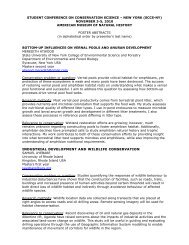EDUCATOR'S GUIDE - American Museum of Natural History
EDUCATOR'S GUIDE - American Museum of Natural History
EDUCATOR'S GUIDE - American Museum of Natural History
- No tags were found...
Create successful ePaper yourself
Turn your PDF publications into a flip-book with our unique Google optimized e-Paper software.
TEACHING IN THE EXHIBITION:<br />
The themes below explore the Key Concepts and represent possible tours through the exhibition. Locations are<br />
indicated in italicized text.<br />
1. Darwin’s greatest tools were his skills <strong>of</strong> observation<br />
and analysis.<br />
• Charles Darwin’s magnifying glass (Introduction): Why<br />
is this the first object in the exhibit Ask your students<br />
to think about why scientists use tools. Direct them to<br />
find a magnified object/specimen in each section <strong>of</strong> the<br />
exhibit. What observations can they make about each one<br />
Can they find other scientific tools in the exhibition How<br />
was each one used<br />
• A Trip Around the World<br />
section: Ask your students<br />
to observe one or more <strong>of</strong><br />
the live animals in this<br />
section and write down<br />
their observations about<br />
how the animals look, move,<br />
and interact with their<br />
environments.<br />
• Darwin’s Notebooks (The<br />
Idea Takes Shape section):<br />
Young Darwin<br />
Have your students look<br />
at Darwin’s notebooks. What types <strong>of</strong> information did he<br />
record Why is it important for scientists to keep detailed<br />
notes<br />
• Down House and Darwin’s Study (A Life’s Work): Ask your<br />
students what tools Darwin used to conduct his plant and<br />
animal experiments at Down House. How did his observations<br />
and studies contribute to the development <strong>of</strong> his<br />
theory <strong>of</strong> natural selection<br />
proceed through the exhibition, ask them what Darwin<br />
learned from Malthus. What other scientists mentioned<br />
in the exhibit contributed to Darwin’s interpretation and<br />
analysis <strong>of</strong> the evidence he collected How did their different<br />
areas <strong>of</strong> expertise advance Darwin’s understanding <strong>of</strong><br />
the natural world<br />
• Evolution Today section: What evidence can your<br />
students find for ways in which Darwin’s ideas have influenced<br />
evolutionary biologists at work today<br />
3. The evidence that Darwin collected during the fiveyear<br />
voyage <strong>of</strong> the HMS Beagle led to his theory that<br />
species adapt to different environments and change<br />
over time. (All in A Trip Around the World section)<br />
• Rheas: How do these animals suggest the geographic<br />
replacement <strong>of</strong> one species by another<br />
• Armadillos, tree sloth, Glyptodont and Megatherium<br />
fossils: How are these specimens evidence for the replacement<br />
<strong>of</strong> species through time<br />
• Live frogs and iguanas: Ask students to look closely at these<br />
animals’ adaptations. What did Darwin learn from examining<br />
different closely-related species<br />
• Tortoises: What did the differences between varieties/<br />
species on different islands in the Galapagos (microgeographic<br />
replacement) suggest to Darwin<br />
2. Scientific knowledge changes over time, as scientists<br />
test, refine, and add to what is already understood<br />
about the world.<br />
• “Unconformity” display (Young <strong>Natural</strong>ist section): Ask<br />
your students how geological evidence about the age <strong>of</strong> the<br />
Earth revolutionized science during Darwin’s time. How did<br />
these discoveries influence Darwin’s thinking<br />
• World Before Darwin section: Ask students to<br />
consider what 18th century naturalists grasped about<br />
how species were related—and what escaped their<br />
understanding.<br />
• Malthus display (London section): Scientists use the<br />
research, ideas, and theories <strong>of</strong> peers and predecessors<br />
to advance their own investigations. As your students<br />
Galapagos land iguana

















